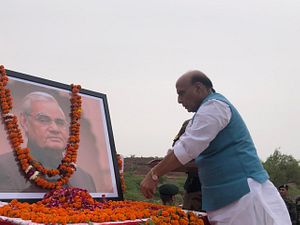India appears to be slowly closing the initial chapter of its life as a possessor of nuclear weapons. Marking the anniversary of the death of Atal Bihari Vajpayee, the prime minister who oversaw India’s nuclear weaponization in 1998, Indian Defense Minister Rajnath Singh became the most senior Indian official to publicly cast doubt on the credibility of India’s long-standing ‘no first use’ posture.
Speaking at Pokhran, where India had detonated weaponized nuclear devices in 1998 (India’s weaponization efforts had begun much earlier in a covert manner), Singh said that “till today, our nuclear policy is ‘no first use’”.
He added: “What happens in the future depends on the circumstances.”
Unlike Manohar Parriker, one of his predecessors who had also questioned the policy, Singh was not speaking off the cuff.
Singh reiterated his statement in a tweet after his remarks at Pokhran. For India’s two main nuclear adversaries, Pakistan and China, the statement wasn’t surprising. Rather, it was a vindication of longstanding skepticism in China and Pakistan of “no first use”.
Mutual skepticism prevails in particular between India and China. Few Indian strategists take China’s decades-long “no first-use” posture at face value, even given Beijing’s attempts over the years to back up its declaratory policy with its nuclear force structure — for example, by separating warheads and launchers.
The impulses driving India’s gradual shift away from its commitment to ‘no first use’ are born of two factors. First, Pakistan’s lowering of the nuclear-use threshold in South Asia by developing low-yield nuclear weapons has constrained Indian options. Islamabad’s development of these capabilities largely coincided with its increased use of terrorist groups as proxies in Indian territory. In New Delhi, the perception that it is being bled with a hundred cuts with little room to respond conventionally has become a source of frustration.
Second, as Singh hinted, Vajpayee’s stewarding of nuclear India brought New Delhi status and benefits, including a bespoke status of sorts in the community of nuclear nations. India was a nuclear state outside of the Nuclear Nonproliferation Treaty that, by 2008 — a decade after India’s weaponized tests — had considerable access to commercial nuclear technology on the global market. This was largely due to the 2005 US-India civil nuclear deal and the 2008 waiver New Delhi received from the Nuclear Suppliers Group.
India’s doctrine hasn’t changed and isn’t probably changing imminently, but its ‘no first use’ commitment is more porous than it has ever been. Even in the 2003 official doctrine that codified the policy, New Delhi included a carve-out for its first use of nuclear weapons: biological and chemical weapons used against its forces.
Singh’s comment on future conditions, in particular, can be read in a way that effectively renders India’s ‘no first use’ commitment meaningless. Certainly there are several circumstances that might strike the imagination of policymakers in New Delhi where first use would be warranted.
Singh’s remarks are also evidence of a decoupling between India’s approaches toward Pakistan and China. Importantly, there is little reason to believe that fears about China are behind these shifts in Indian thinking about first-use nuclear policy; instead, Indian investments in new, longer-range capabilities are all about continuing to deter Beijing.
For Pakistan, however, India is maneuvering not only in capabilities, but also policy.
Prime Minister Narendra Modi himself on the campaign trail earlier this year beat the nuclear drum to stir up his nationalist base. At an April 20 rally, he told supporters: “Every other day, they used to say ‘we have nuclear button, we have nuclear button’. What do we have then? Have we kept it for Diwali?” While that might be written off as just a bit of electioneering theater, it takes on a new weight with Singh — one of Modi’s closest confidants and, as noted, the incumbent defense minister — saying what he did.
Either way, we shouldn’t be surprised should Modi’s second term lead to more overt changes in India’s nuclear policy. Modi has shown himself willing to take risks: recent moves in Kashmir, the 2016 demonetization decision, and the strikes on Pakistan earlier this year speak to that tendency. Nuclear policy may not be as sacrosanct as it once might have been.
A version of this article appeared in the South China Morning Post. It is republished here with kind permission.

































